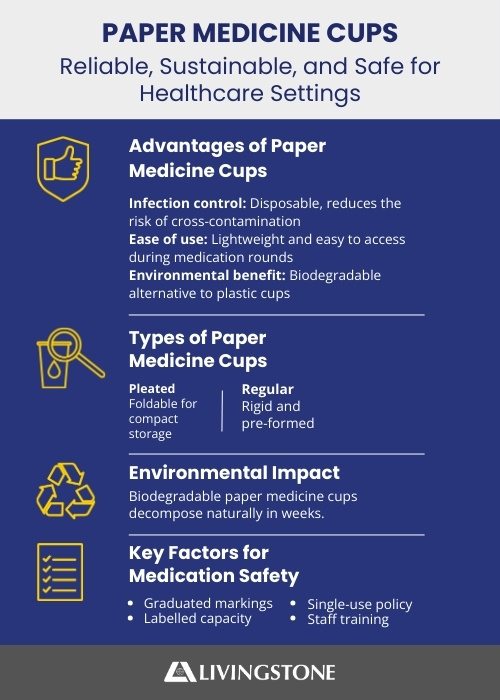In professional healthcare environments, whether in aged care, hospitals, dental surgeries, or first aid clinics, hygiene and sustainability are essential. Among the many consumables that support safe and effective care, paper medicine cups play a crucial yet often overlooked role. Designed for accurate dosage, single-use safety, and environmentally responsible disposal, they have become a preferred choice for many healthcare providers across Australia.

Why Paper Medicine Cups are Widely Used
Paper medicine cups are designed for single-use applications in the safe dispensing of liquid medicines, tablets, and powders. Compared with reusable or plastic alternatives, they offer several key advantages:
- Infection control – Being disposable, they reduce the risk of cross-contamination between patients.
- Ease of use – Lightweight, stackable, and quick to access during medication rounds.
- Environmental benefit – Biodegradable pulp cups decompose naturally, making them a lower-impact option than traditional plastics.
In high-turnover environments such as hospital wards or aged care units, these features support both clinical safety and operational efficiency.
Pleated vs Regular Paper Medicine Cups
In healthcare procurement, understanding the functional difference between pleated paper medicine cups and regular paper medicine cups helps ensure the right product is selected for each setting.
- Pleated paper pill cups feature a folded, accordion-like design. They store flat, conserving space in supply rooms and trolleys. The pleated walls expand to form a sturdy cup when opened, making them practical for mobile healthcare services, medication rounds, and emergency kits.
- Regular (unpleated) paper medicine cups are pre-formed and rigid. They are quicker to use in high-throughput environments such as hospital wards or dental surgeries where medication or rinse solutions are dispensed frequently.
Choosing between the two depends on storage constraints, handling preferences, and workflow demands.
Environmental Impact and Waste Management
Biodegradable paper medicine cups break down naturally in composting or general waste environments, unlike single-use plastics that persist for decades. For healthcare providers working to meet sustainability targets, switching to biodegradable options can significantly reduce plastic waste without compromising infection control.
Facilities are encouraged to align with national sustainable packaging guidelines and incorporate waste segregation practices to maximise the environmental benefits of biodegradable consumables.
Integrating Paper Medicine Cups into Clinical Practice
When implementing paper medicine cups in healthcare settings, consider:
- Volume variety – Common sizes include 15 mL, 30 mL, 50 mL, and 60 mL, each suited to different dosage requirements.
- Graduation visibility – Cups with internal and external graduations can be read from multiple angles.
- Labelled capacity – Numbered markings can reduce the risk of misreading during busy rounds.
- Bulk availability – Maintaining adequate supply helps avoid last-minute substitutions that could compromise measurement accuracy.
Best Practices for Preventing Medication Errors
While the right equipment is important, the prevention of medication errors relies equally on robust procedures and training. Integrating Livingstone’s graduated paper medicine cups into a structured medication safety program supports the following best practices:
- Standardised measurement techniques – Staff should pour to eye level and read graduations accurately.
- Appropriate cup selection – Match cup size and graduation style to the medication form and dosage volume.
- Single-use policy – Dispose of cups immediately after use to avoid accidental reuse or cross-contamination.
- Clear labelling and visibility – Choose cups with clear numerical markings for quick verification.
- Staff training and competency assessment – Reinforce correct dosing techniques and handling procedures in regular training sessions.
Combining these measures with high-quality, accurately marked medicine cups strengthens patient safety across all care settings.
Paper medicine cups are a small but critical component of medication safety and environmental responsibility in healthcare. Their disposability supports infection control, their graduations enable accurate dosing, and their biodegradable nature helps meet sustainability goals.
Whether in aged care, acute hospital wards, dental clinics, or first aid settings, choosing the right type of paper medicine cup—pleated or regular, small or large capacity—can support both patient safety and operational efficiency. By pairing these consumables with robust training and medication protocols, healthcare providers can enhance outcomes while reducing environmental impact.
For further information on safe handling and disposal procedures, healthcare professionals can refer to the Clinical waste guidelines — supplement for healthcare staff, which provides detailed instructions on segregation, storage, and environmental management in clinical environments.
References
- Australian Packaging Covenant Organisation (n.d.) National Packaging Targets. Available at: https://apco.org.au/national-packaging-targets (Accessed: 14 August 2025).
- Capital Health Care Pty Ltd (n.d.) Clinical waste guidelines — supplement for healthcare staff. Available at: https://www.capitalhealthcare.com.au/uploads/5/9/8/4/59845473/capital_health_care_pty_ltd_-_clinical-waste-guidelines-supplement-for-healthcare-staff.pdf (Accessed: 14 August 2025).
